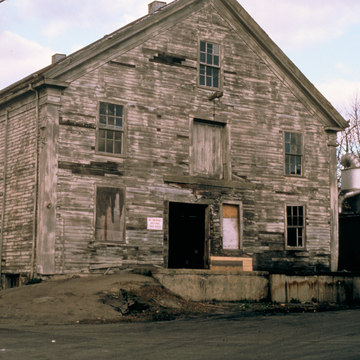Inside the century-old Plymouth Rubber Company complex survives a remnant of one of the first sheet metal facilities in the country. Paul Revere, in addition to being a fine colonial silversmith and Revolutionary patriot, was the first American to master the technology of rolling copper—primarily for sheet copper used on the hulls of U.S. Navy vessels. To match European production required large government loans that helped Revere buy foreign ore and establish his rolling mill at Canton in 1801. Successive contracts with the government kept the Revere Copper Works (1801–1828) profitable. Although no structures from this earliest period remain, there is a mid-nineteenth-century stone and brick rolling mill and a two-story Greek Revival wooden barn, plus the sluiceway and stone revetment wall, built for the Revere Copper Company (1828–1869). This successor firm, formed by his son Joseph Warren Revere and F. W. Lincoln, sold the site to Plymouth Rubber in 1911 to rebuild elsewhere. Plymouth Rubber cleared much of the site and added the three-story brick Building 8 (1912) that adjoins the rolling mill and the two-story concrete office building (1917). Two modern descendants of the original firm are Revere Copper and Brass, Inc., and the Revere Ware division of Borden Inc., which continues to produce the copperware kitchen utensils that long sustained the Revere Copper Company.
You are here
Revere Copper Company
If SAH Archipedia has been useful to you, please consider supporting it.
SAH Archipedia tells the story of the United States through its buildings, landscapes, and cities. This freely available resource empowers the public with authoritative knowledge that deepens their understanding and appreciation of the built environment. But the Society of Architectural Historians, which created SAH Archipedia with University of Virginia Press, needs your support to maintain the high-caliber research, writing, photography, cartography, editing, design, and programming that make SAH Archipedia a trusted online resource available to all who value the history of place, heritage tourism, and learning.















